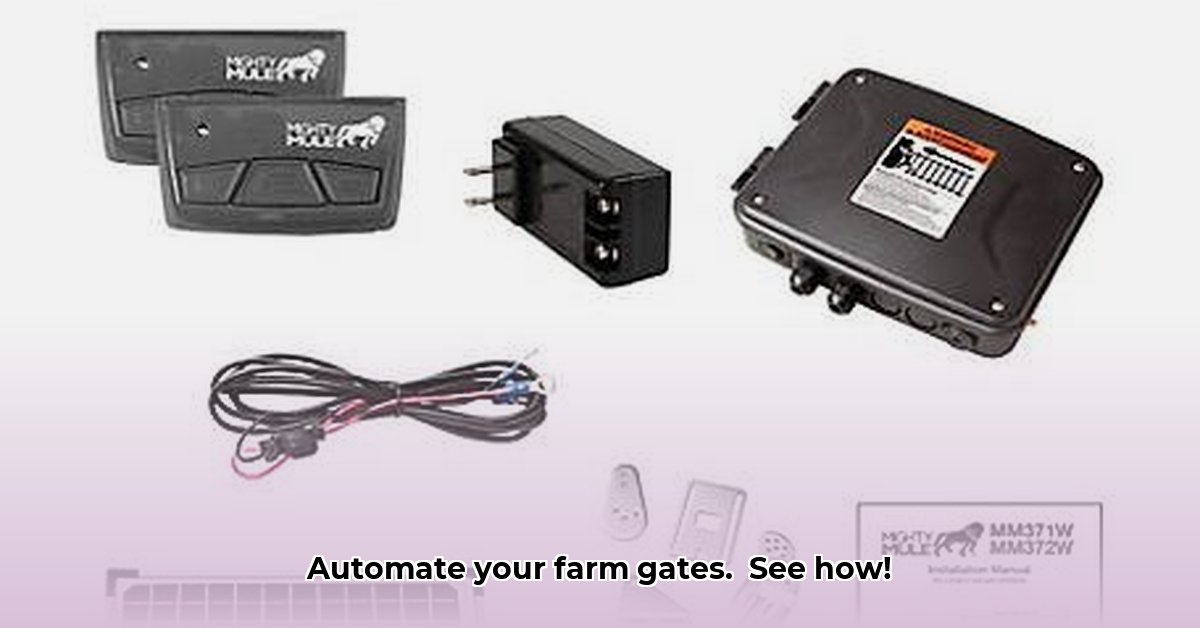
Features and Specifications: A Detailed Look
The Tractor Supply Mighty Mule gate opener offers a convenient solution for automating farm gates, promising increased efficiency and reduced labor. While various models exist (single or double-swing), this review focuses on common features and specifications. Always consult Tractor Supply's website for precise details on the specific model you're considering. For more model details, check out Tractor Supply's website.
Power Source: Most models operate on standard 120V household current, simplifying installation. Some offer 12V DC battery operation for remote locations. Battery life will vary with usage frequency. Think of it like a smartphone battery; more frequent use requires more frequent charging.
Gate Weight Capacity: The maximum weight a Mighty Mule can handle varies depending on the model. Crucially, verify your gate's weight before purchasing to avoid overloading the system and potential damage. Overloading risks malfunction and potentially unsafe operation.
Opening/Closing Speed: The opener isn't lightning fast, but it significantly surpasses manual operation, saving valuable time. This difference will be particularly noticeable in periods with heavy use.
Wireless Range: The remote control offers a reliable operating range. However, factors like interference from other wireless devices might affect distance. Environmental conditions will play a role.
Security: Many models employ a rolling code system to prevent unauthorized access, enhancing farm security. This feature adds an important layer of security to your property.
Installation and Setup: A Step-by-Step Guide
Installing a Mighty Mule requires some DIY skills but remains manageable for most users. The BILT app (where available) streamlines the process. Here's a general guide:
Planning & Measurement: Precisely measure your gate and assess the installation area. A properly balanced gate is essential for smooth operation. Poor planning can lead to installation difficulties.
Motor Mounting: Securely attach the motor unit to your gate post according to the instructions. Accurate mounting ensures reliable and safe operation.
Wiring: Connect the power source and control wiring, paying close attention to polarity to avoid electrical issues. Incorrect wiring can damage the system.
Remote Programming: Program the remotes, carefully following the instructions (usually involving button sequences). Improper programming renders the remote useless.
Testing & Adjustment: Thoroughly test the opener after installation, making adjustments as needed for optimal performance. Fine-tuning ensures efficient and consistent operation.
Performance Evaluation: Real-World Considerations
User feedback suggests the Mighty Mule performs well in various conditions. However, some limitations exist:
Long-Term Reliability: While generally reliable, mechanical parts eventually wear out. Regular maintenance is crucial for extended lifespan. Just like a car, regular maintenance extends its life significantly.
Weather Resistance: Extreme weather can affect performance. While designed for some weather, harsh conditions might require additional weatherproofing. Severe conditions can affect the system and necessitate extra protection.
Durability: The components seem sturdy for many farm uses, but demanding conditions may accelerate wear and tear. Prolonged exposure to extreme temperatures or moisture can accelerate degradation.
Long-Term Data: Limited long-term data currently exists. More time is needed for a complete assessment of long-term reliability. This is an area needing further study and user feedback.
Integration with Other Systems: Expanding Functionality
While not intrinsically part of a “smart farm” system, the Mighty Mule has integration potential. Adding it to an existing system might require additional hardware and software, potentially linking it with irrigation or other IoT devices. This interoperability could enhance farm management capabilities. This potential needs further exploration.
Cost-Benefit Analysis: Return on Investment
Though initial costs are competitive, the long-term benefits are significant. Consider these factors:
- Initial Cost: This includes the opener, materials (if needed), and installation labor.
- Annual Costs: Account for electricity/battery replacement and potential maintenance.
- Labor Savings: Calculate the time saved daily/weekly through automation.
- Efficiency Gains: Consider improvements to workflow (e.g., precise livestock control).
- ROI Calculation: Subtract annual costs from annual savings, then divide by the initial investment. A positive ROI suggests a worthwhile investment.
Pros and Cons: A Balanced Perspective
| Pros | Cons |
|---|---|
| Relatively easy installation | Limited long-term reliability data |
| Cost-effective | Potential weather-related performance limitations |
| Improved farm efficiency | Requires basic DIY skills and patience |
| Enhanced security features | No inherent smart farm integration |
| Convenient remote operation | May need weatherproofing in extremely harsh conditions |
Conclusion: Is the Mighty Mule Right for You?
The Mighty Mule gate opener represents a compelling option for automating farm gates. Consider its features, cost, and potential integration with your existing systems. Its long-term reliability, however, still requires further validation through continued use and user reports. Ultimately, its value hinges on your specific needs and farming operation. Check Tractor Supply's website for the most up-to-date information and model availability.